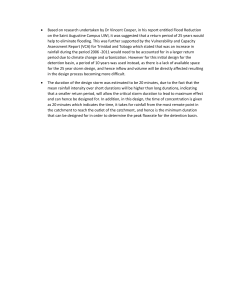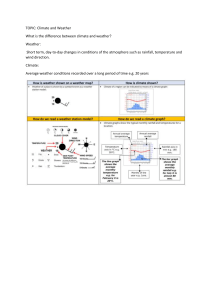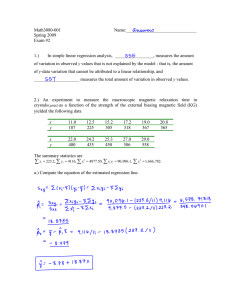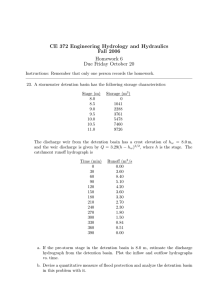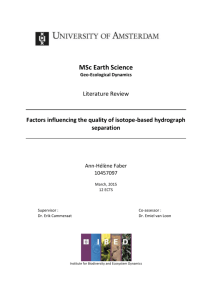Uploaded by
WAMBUZI SAMUEL WILLIAM
Base Flow Separation Methods in Watershed Hydrology
advertisement
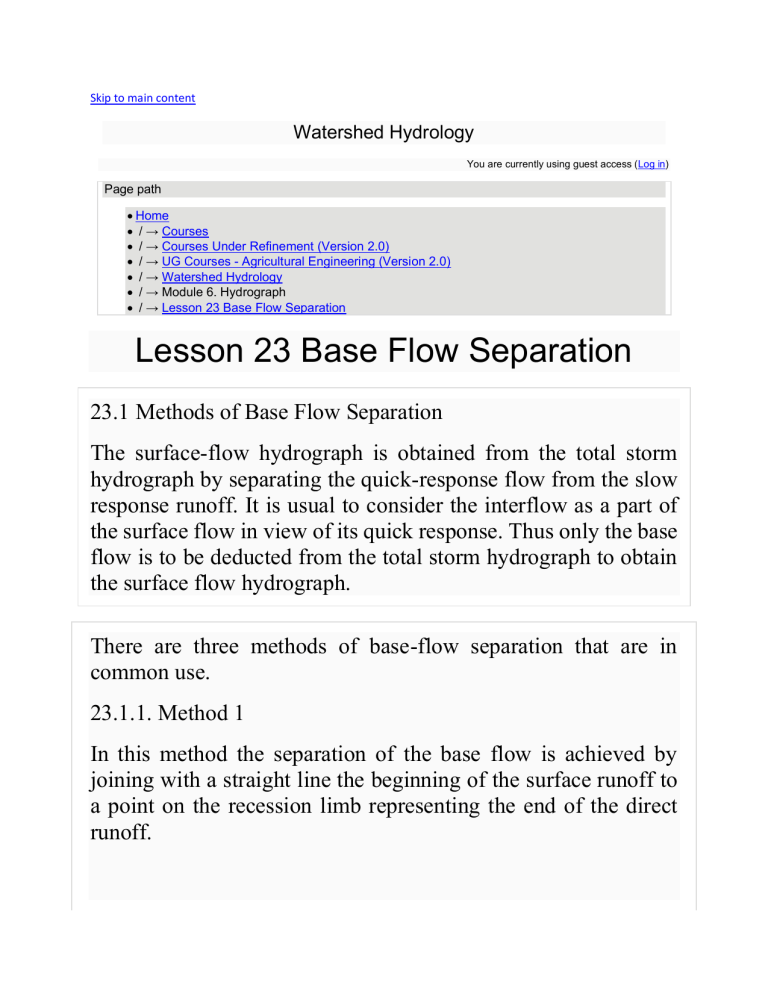
Skip to main content Watershed Hydrology You are currently using guest access (Log in) Page path • Home • / → Courses • / → Courses Under Refinement (Version 2.0) • / → UG Courses - Agricultural Engineering (Version 2.0) • / → Watershed Hydrology • / → Module 6. Hydrograph • / → Lesson 23 Base Flow Separation Lesson 23 Base Flow Separation 23.1 Methods of Base Flow Separation The surface-flow hydrograph is obtained from the total storm hydrograph by separating the quick-response flow from the slow response runoff. It is usual to consider the interflow as a part of the surface flow in view of its quick response. Thus only the base flow is to be deducted from the total storm hydrograph to obtain the surface flow hydrograph. There are three methods of base-flow separation that are in common use. 23.1.1. Method 1 In this method the separation of the base flow is achieved by joining with a straight line the beginning of the surface runoff to a point on the recession limb representing the end of the direct runoff. In Fig. 23.1, pointA represents the beginning ofthe direct runoff off and it is usually easy to identify in view of the sharp change in the runoff rate at that point. Point B, marking the end of the direct runoff is rather difficult to locate exactly. Fig. 23.1. Method 1 for separation.(Source:Subramanya, 2008) base flow An empirical equation for the time interval N (days) from the peak to the point B is (23.1) WhereA is drainage area in km2and N is in days. Points A and B are joined by a straight line to demarcate to the base flow and surface runoff. This method of base-flow separation is the simplest of all the three methods. 23.1.2 Method 2 In this method the base flow curve existing prior to the commencement of the surface runoff is extended till it intersects the ordinate drawn at the peak (point C in Fig. 23.2). This point is joined to point B by a straight line. Segment AC and CB demarcate the base flow and surface runoff. This is probably the most widely used base-flow separation procedure. Fig. 23.2. Method 2 (Source:Subramanya, 2008) for base flow separation. 23.1.3 Method 3 In this method the base flow recession curve after the depletion of the flood water is extended backwards till it intersects the ordinate at the point of inflection (line EF in Fig. 23.3). Points A and F are joined by an arbitrary smooth curve. This method of base-flow separation is realistic in situations where the groundwater contributions are significant and reach the stream quickly. Fig. 23.3. Method 3 (Source:Subramanya, 2008) for base flow separation. The surface runoff hydrograph obtained after the base-flow separation is also known as direct runoff hydrograph (DRH). Example 1 The following are the ordinates of the hydrograph of flow from a catchment area of 770 km2 due to a 6-h rainfall. Derive the ordinates of DRH. Make suitable assumptions regarding the base flow. Time from beginning of storm (h) Discharge (m3/ 21 36 40 35 27 42 65 s) 5 0 0 0 0 0 6 12 18 24 30 36 Time from beginning of storm (h) Discharge (m3/ 20 14 10 70 50 42 s) 5 5 0 42 48 54 60 66 72 Answer: Given: catchment area (A) = 770 km2 Using equation 23.1, From given data, with our convenience, base flow = 42 m3/s at 72 h Therefore, DRH = Flood Hydrograph – Base flow Time from beginning Discharge Base flow DRH of storm h m3/s m3/s m3/s 0 40 42 -2 6 65 42 23 12 215 42 173 18 360 42 318 24 400 42 358 30 350 42 308 36 270 42 228 42 205 42 163 48 145 42 103 54 100 42 58 60 70 42 28 66 50 42 8 72 42 42 0 Example 2 The daily stream flow data at a site having a drainage area of 6500 km2 are given in the following table. Separate the base flow using the above three methods. Time (days) Discharge (m3/s) 1 1600 2 1550 3 5000 4 11300 5 8600 6 6500 7 5000 8 3800 9 2800 10 2200 11 1850 12 1600 13 1330 14 1300 15 1280 Answer 1. Plot the total runoff hydrographMethod 1: join point A, the beginning of direct runoff, to point B, the end of direct runoff. Both points are selected by judgment. 2. Method 2: Extend the recession curve before the storm up to point C below the peak. Join point C to D, computed using equation 3. Method 3: Extend the recession curve backward to point E. Join point E to A 4. The ordinates DRH by three methods are given in Table Table Ordinates of DRH by different methods Base flow Direct runoff Tim e Total runoff (da ys) (m3/s) (m3/s) (m3/s) (m3/s) (m3/s) (m3/s) (m3/s) 1 1600 1600 1600 1600 0 0 0 2 1550 1550 1550 1550 0 0 0 3 5000 1520 1480 1500 3480 3520 3500 4 11300 1500 1400 1450 9800 9900 9850 5 8600 1450 1700 1400 7150 6900 7200 6 6500 1450 1950 1400 5050 4550 5100 7 5000 1450 2300 1400 3550 2700 3600 8 3800 1400 2550 1400 2400 1250 2400 9 2800 1380 2800 1380 1420 0 1420 Meth od 1 Meth od 2 Meth od 3 Meth od 1 Meth od 2 Meth od 3 10 2200 1380 2200 1380 820 0 820 11 1850 1380 1850 1380 470 0 470 12 1600 1350 1600 1350 250 0 250 13 1330 1330 1330 1330 0 0 0 14 1300 1300 1300 1300 0 0 0 15 1280 1280 1280 1280 0 0 0 23.2 Effective Rainfall Hyetograph Effective rainfall (also known as Excess rainfall) (ER) is that part of the rainfall that becomes direct runoff at the outlet of the watershed. It is thus the total rainfall in a given duration from which abstractions such as infiltration and initial losses are subtracted. For purposes of correlating DRH with the rainfall which produced the flow, the hyetograph of the rainfall is also pruned by deducting the losses. Figure 23.4 shows the hyetograph of a storm. The initial loss and infiltration losses are subtracted from it. The resulting hyetograph is known as effective rainfall hyetograph (ERH). It is also known as excess rainfall hyetograph. Fig. 23.4.Effective rainfall hyetograph. (Source:Subramanya, 2008) Both DRH and ERH represent the same total quantity but in different units. Since ERH is usually in cm/h plotted agains1 time, the area of ERH multiplied by the catchment area gives the total volume of direct runoff which is the same as the area of DRH. Theinitial loss and infiltration losses are estimated based on the available data of the catchment. Example 3 A 4-hour storm occurs over an 80 km2 watershed. The details of the catchment are as follows: Sub Area Φ index Hourly rain (mm) km2 mm/h 1st hour 2nd hour 3rd hour 4th hour 15 10 16 48 22 10 25 15 16 42 20 8 35 21 12 40 18 6 5 16 15 42 18 8 Calculate the runoff from catchment and the hourly distribution of the effective rainfall whole catchment. Answer: Totalrunoff = 2.46Mm3 Hourly distribution of the effective rainfall for the whole catchment: Effective rainfall (mm) 1st hour 1.4375 2nd hour 25.375 3rd hour 0 4th hour 3.9375 Example 4 A storm in a certain catchment had three successive 6-h intervals of rainfall magnitude of 3.0 cm, 5.0 cm and 4.0 cm, respectively. The flood hydrograph at the outlet of the catchment resulting from this storm is as follows: ime (h) 0 6 12 18 24 30 36 42 lood hydrograph ordinates (m3/s) 30 480 2060 4450 6010 6010 5080 399 ime 48 54 (h) 60 66 72 78 lood hydrograph ordinates (m3/s) 2866 1866 1060 500 170 30 If the area of the catchment is 8791.2 km2, estimate the index of the storm. Assume the base flow as 30 m3/s. Answer Flood hydrograph ordinates = DRH ordinates +Base flow ordinates Direct runoff(cm) = Where is direct runoff ordinates (m3/s), is time interval between successive ordinates (h), A is catchment area (km2) Time Flood hydrograph Ordinates Base flow DRO h m3/s m3/s m3/s 0 30 30 0 6 480 30 450 12 2060 30 2030 18 4450 30 4420 24 6010 30 5980 30 6010 30 5980 36 5080 30 5050 42 3996 30 3966 48 2866 30 2836 54 1866 30 1836 60 1060 30 1030 66 500 30 470 72 170 30 140 78 30 30 0 = 34188 Therefore, Direct runoff (cm) = Directrunoff (cm) = 8.4 Therefore φ = 0.2cm/h Rainfall (cm) 3 5 4 Time interval (h) 6 6 6 Rainfall intensity (cm/h) 0.5 0.833 0.667 index (cm/h) 0.2 0.2 0.2 Excess rainfall intensity 0.3 0.633 0.467 23.3 Elemental Hydrograph If a small, impervious area is subjected to a constant rate rainfall, the resulting runoff hydrograph will appear much as above, and is known as elemental hydrograph (Fig. 23.5). In the beginning, there will be surface detention (rainfall-runoff) so as to start the sheet flow over the surface. At point B, known as point of equilibrium, outflow rate equals inflow rate. When rainfall ends (at C), recession starts, i.e., outflow rate and detention volume increases. Fig. 23.5.Elemental hydrograph. (Source:Singh,1994) References Singh, V. P. (1994). Elementary Hydrology, Prentice Hall of India Private Limited, 451. Subramanya, K. (2008). Engineering Hydrology, Third edition, Tata McGraw Hill, 202-203. Suggested Reading Murty, V.V.N. and Jha, M.K. (2009).Land and Water Management Engineering.Fifth edition, Kalyani Publishers, Ludhiana. Suresh R. (2007). Soil and Water Conservation Engineering.Fourth edition, Standard Publishers Distributors, New Delhi. Last modified: Saturday, 15 March 2014, 6:34 AM You are currently using guest access (Log in) Watershed Hydrology Switch to the standard theme


